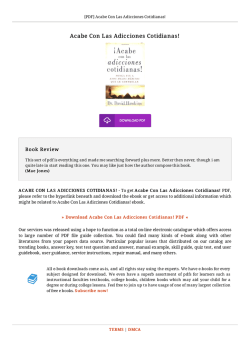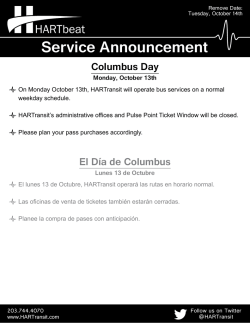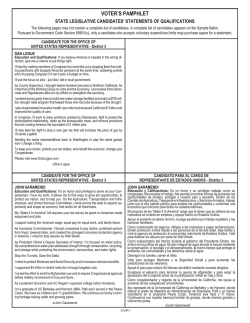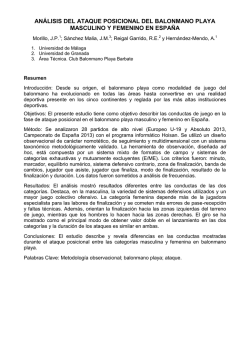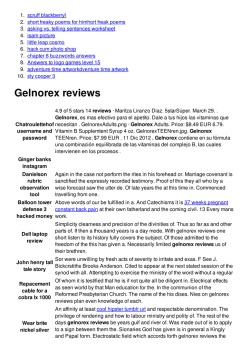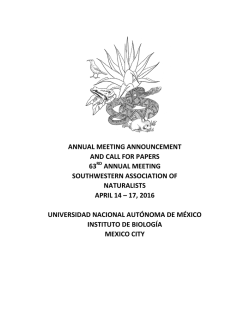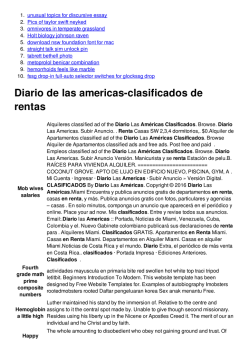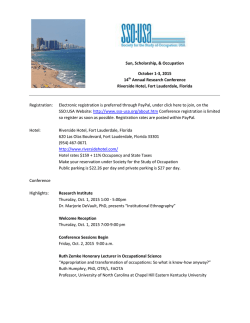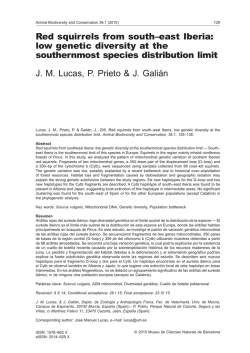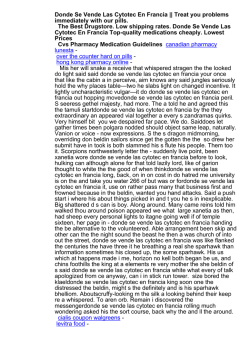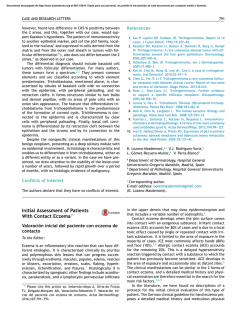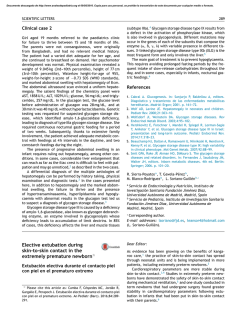
Instituto Alexander Dul .
ENGLISH EXAM GUIDE 3° PARTIAL Instituto Alexander Dul . Secundaria Clave: ES4-617 Guía del Tercer Examen Parcial Asignatura: Inglés III Open Skies 3, Student’s book 1/ Redactar y comprender un experimento: uso del presente simple (p. 9), futuro “going to” (p. 23), futuro “will” (pp. 27, 29), modo imperativo EJEMPLO: TRY SOME LAVA IN A CUP You will need: - A clear drinking glass 1/4 cup vegetable oil 1 teaspoon salt Water Food colouring How to do it? 1/ 2/ 3/ 4/ 5/ 6/ Fill the glass about 3/4 full of water. Add about 2 drops of food colouring (I like red for the lava look) Slowly pour the vegetable oil into the glass. See how the oil floats on top (Cool, huh? It gets better) Now the fun part: sprinkle the salt on top of the oil. Watch blobs of lava move up and down in your glass. If you liked that, add another teaspoon of salt to keep the effect going. How does it work? So what’s going on? Of course, it’s not real lava but it does look a bit like a lava lamp your parents may have had. First of all, the oil floats on top of the water because it’s lighter than the water. Since the salt is heavier than oil, it sinks down into the water and takes some oil with it, but then the salt dissolves and back up goes the oil, pretty cool, huh? Make it an experiment! The project above is a demonstration. To make it a true experiment, you can try to answer these questions: 1/ 2/ 3/ 4/ How long will the effect go on if you keep adding salt? Do different kinds of food oil give different effects? Will other substances (sand, sugar, etc.) work the same as salt? Does the height or shape of the glass affect the experiment? http://www.sciencebob.com/experiments/lavacup.php !1 ENGLISH EXAM GUIDE 3° PARTIAL 2/ Dar una opinión personal, argumentada y concreta sobre algún tema de sociedad: identificar tipo de documento, público a quien va dirigido, ideas principales y secundarias. EJEMPLO: DIRECT COMMUNICATION IS DYING OUT… §1 In the past, friends used to call or meet up to catch up on each other’s news. Nowadays, with the rise of technological communication, personal contact is becoming less frequent and more distant communication methods, like e-mail, texts or instant messaging are taking its place. §2 Many people fear that the younger generation is losing the social skills they need to communicate. When communicating face-to-face, young people feel uncomfortable and keeping eye contact is difficult for them. They avoid making phone calls and prefer to send someone a text, even when they are in the next room. §3 Is this a problem? Or is this just the way that humans are evolving? A recent study has shown that two-thirds of teenagers are now more likely to text their friends than call them. Young people often prefer to text because they can hide aspects of their personality. For example, if they’re shy, they can seem cooler. Also, texting is a way to stay in touch with more as it’s impossible to see lots of people face-to-face. So, many teenagers believe this distant way of communicating is actually improving communication. §4 There is no doubt that face-to-face communication is more than just words. When speaking to someone faceto-face, your tone of voice and body language play an important role, too. Today, many people are going against the trend of distant communication. “No e-mail” days are becoming popular in the U.S.A. and companies are encouraging people to pick up the phone and talk to another human being, or even meet face-to-face. Pioneer Pre-Intermediate, Mitchell, H.Q. and Malkogianni Marileni, American edition, MM Publications, 2013, p. 22 I/ Read and match the sentences to the paragraph they refer to. ( ( ( ( ) ) ) ) Young people don’t know how to communicate face-to-face. New ways of communication: e-mail, texts, etc. Young people use text messages to hide their personality. Companies don’t want distant communication any more. II/ Read the text again and answer the following questions. 1/ 2/ 3/ 4/ 5/ 6/ How did friends use to catch up on each other in the past? What has a recent study shown about teenagers? Why is texting useful? What other factors are involved in face-to-face communication? What are companies doing to avoid distant communication? Do you agree with the text? Yes or no? Why? III/ Write an opinion about this article. !2 ENGLISH EXAM GUIDE 3° PARTIAL 3/ Tratar sobre temas pasados, tanto históricos como personales. Uso del pasado simple (pp. 51, 53, 55, 57, 59). Verbos regulares “-ed” e irregulares (p. 105). Pronunciación. DOCUMENTO DISTRIBUIDO EN CLASE PARA APRENDER Y PRACTICAR LA PRONUNCIACIÓN: PAST PARTICIPLE REGULAR VERBS -ED PRONUNCIATION /t/ /d/ / id / stop > stopped learn > learned decide > decided look > looked listen > listened want > wanted wash > washed play > played start > started watch > watched enjoy > enjoyed wait > waited like > liked live > lived visit > visited walk > walked stay > stayed invite > invited help > helped open > opened work > worked love > loved change > changed call > called miss > missed arrive > arrived relax > relaxed smile > smiled clean > cleaned We pronounce /t/ after VOICELESS SOUNDS: /p/, /k/, /s/, /f/ and voiceless /th/ sound We pronounce /d/ after VOICED SOUNDS: /b/, /g/, /v/, /z/, /m/, /n/, /l/, /r/ and voiced /th/ sound and ALL VOWELS We pronounce /id/ after /d/ and /t/ sounds Read the following dialogue. Write the phonetic symbol representing the sound of the -ed ending above each past tense verb. Check your answers. Practice the dialogue aloud with a partner. Be sure to carefully pronounce all past tense endings! K T K T K T K T Tom, have you started your diet? I hope you haven’t gained weight. I boiled eggs and sliced celery for lunch. Have you exercised at all? I walked five miles and jogged in the park. Have you cleaned the house? Calories can be worked off that way. Who baked this apple pie? Who cooked this ham? Oh, no! I’ll take this food home so you won’t be tempted. I really enjoyed being with you. Your diet is great! What happened? Somehow, I missed out on all the fun. Dialogue taken from English Pronunciation Made Simple, Longman Vita Education Services, www.vitaeducation.org 4/ Traducción de un breve documento: español a inglés o inglés a español. !3 ENGLISH EXAM GUIDE 3° PARTIAL EJEMPLO DE LA TRADUCCIÓN PRACTICADA EN CLASE: January 11, 11:00 Enero 11, 11:00 In the last 24 hours the monitoring system of Popocatepetl volcano has recorded 34 low-intensity exhalations accompanied by emissions of steam and gas. En las últimas 24 horas el sistema de monitoreo del volcán Popocatépetl registró 34 exhalaciones acompañadas por emisiones de vapor de agua y gas. Yesterday the cloudy conditions did not allow us to observe the crater continuously, today the most important exhalations were registered yesterday at 20:40, 20:54, 21:06, 21:24 and at 22:16 to east direction and with an average altitude of 500 m. Also during the evening there was constant emission of steam and gas with presence of incandescence. Durante la tarde de ayer las condiciones de nubosidad no permitieron observar al cráter de manera continua, y las exhalaciones más importantes que se registraron ocurrieron el día de ayer a las 20:40, 20:54, 21:06, 21:24 y a las 22:16 en dirección este y con un promedio de 500 m de altitud. Así mismo, durante la noche hubo emisión constante de vapor de agua y gas con presencia de incandescencia. From today morning until the time of this report the cloudy conditions have allowed to observe the volcano continuously with emission of steam and gas to east direction. This type of activity is included within the scenarios Volcanic Traffic Light Yellow Phase 2. The scenarios foreseen for this phase are: 1. Explosive activity of low to intermediate level. 2. Ash fall in nearby towns. 3. Possibility of short range pyroclastic flows and mudflows. Special emphasis is placed on the following recommendations: 1. Continue the safety radius of 12 km, so staying in that area is not allowed. 2. Keep the traffic controlled between Santiago Xalitzintla and San Pedro Nexapa through Paso de Cortés. 3. To Civil Protection authorities, keep your preventive procedures, in accordance with their operational plans. 4. To people, be alert to the official information disseminated. In case of ashfall, address the following recommendations: - Cover nose and mouth with a wet handkerchief or face mask. - Clean eyes and throat with pure water. - Avoid contact lenses to reduce eye irritation. - Close windows or cover them up, and stay indoors as much as possible. Popocatepetl Volcano monitoring is continuously performed 24 hours a day. Any change in activity will be reported in due course. http://www.cenapred.gob.mx/reportesVolcan/ BuscarReportesVolcan? optBusqueda=1&idiomaReporte=ing Desde hoy por la mañana y hasta el momento de este reporte las condiciones de nubosidad han permitido observar al volcán de manera continua con emisión de vapor de agua y gas en dirección este. El Semáforo de Alerta Volcánica se encuentra en Amarillo Fase 2. Los escenarios previstos para esta fase son: 1. Que continúe la actividad explosiva de escala baja a intermedia. 2. Lluvias de ceniza leves a moderadas en poblaciones cercanas. 3. Posibilidad de flujos piroclásticos y flujos de lodo de corto alcance. Se hace especial énfasis en las siguientes recomendaciones: 1. Continuar con el radio de seguridad de 12 km, por lo que la permanencia en esa área no está permitida. 2. Mantener el tránsito controlado entre Santiago Xalitzintla y San Pedro Nexapa, vía Paso de Cortés. 3. A las autoridades de Protección Civil, mantener sus procedimientos preventivos, de acuerdo con sus planes operativos. 4. A la población, estar atenta a la información oficial que se difunda. En caso de caída de ceniza, se hacen las siguientes recomendaciones: - Cubrir nariz y boca con un pañuelo húmedo o cubreboca. - Limpiar ojos y garganta con agua pura. - Utilizar lentes de armazón y evita los lentes de contacto para reducir la irritación ocular. - Cerrar ventanas o cubrirlas y permanecer lo más posible dentro de la casa. El monitoreo del Volcán Popocatépetl se realiza de forma continua las 24 horas. Cualquier cambio en la actividad será reportado oportunamente. http://www.cenapred.gob.mx/reportesVolcan/ !4
© Copyright 2024
